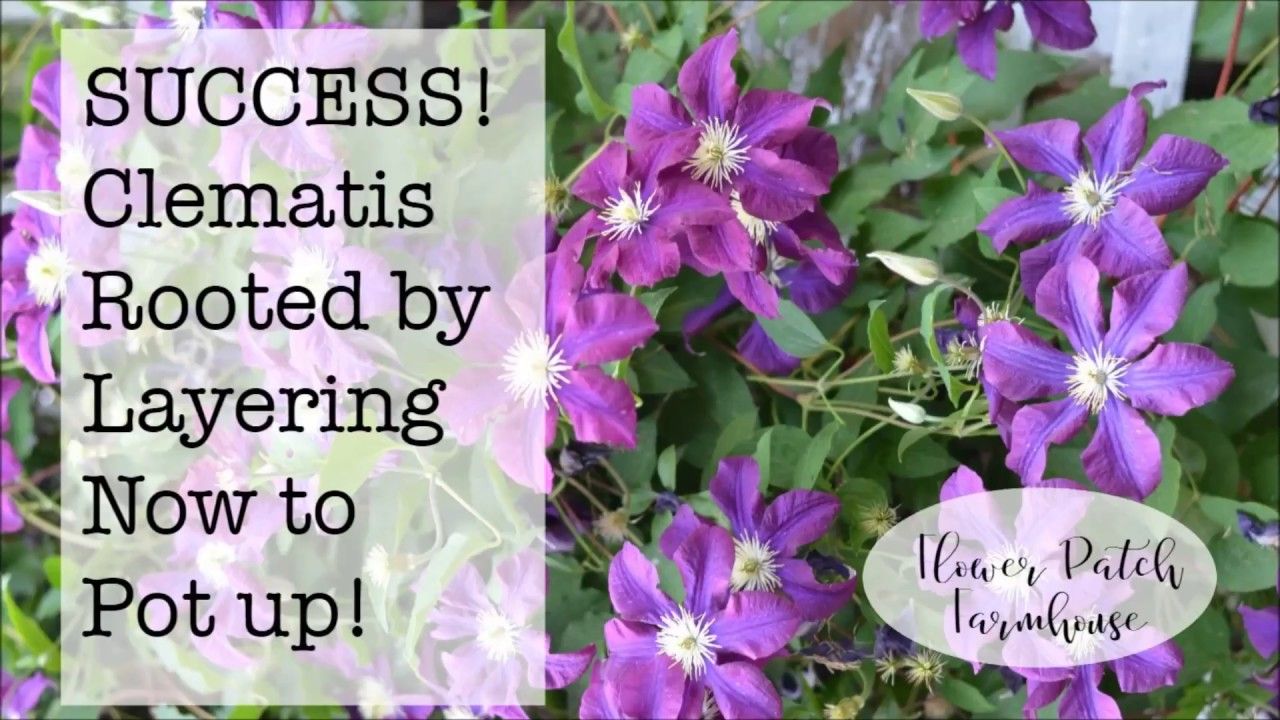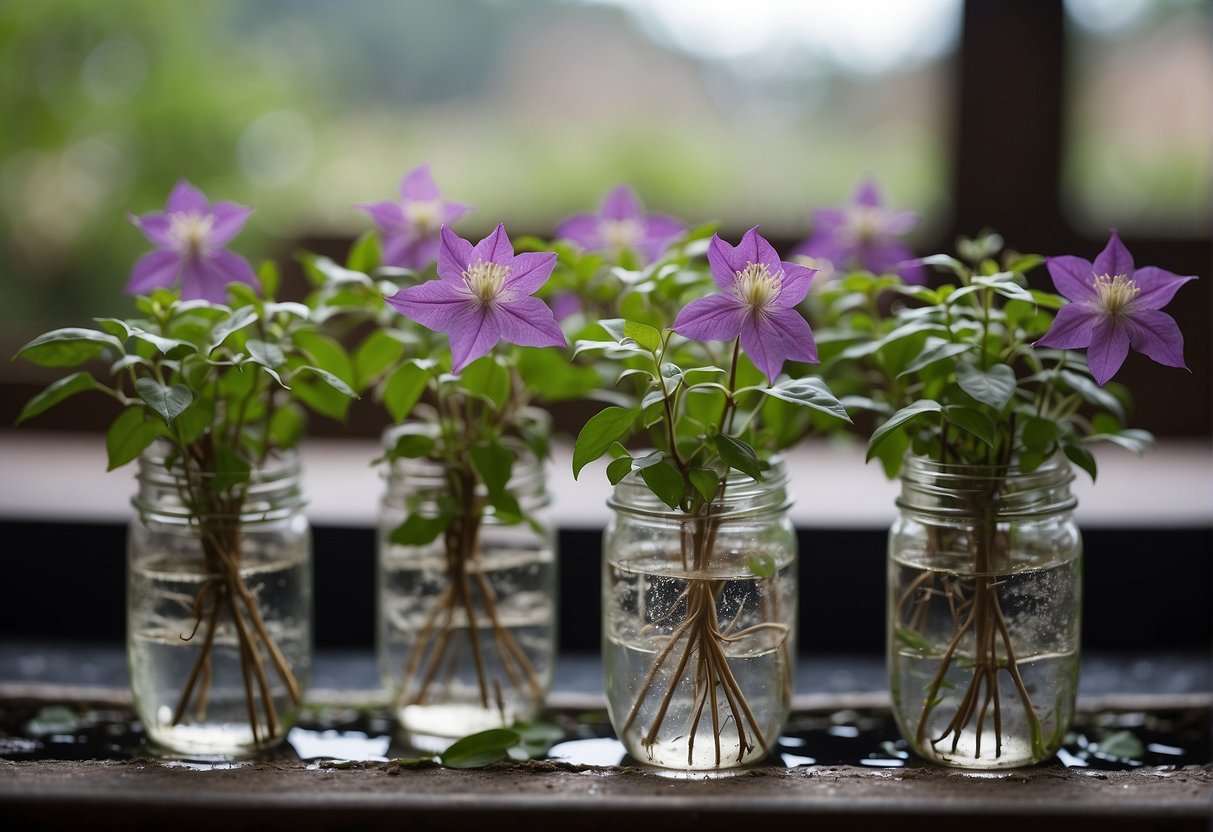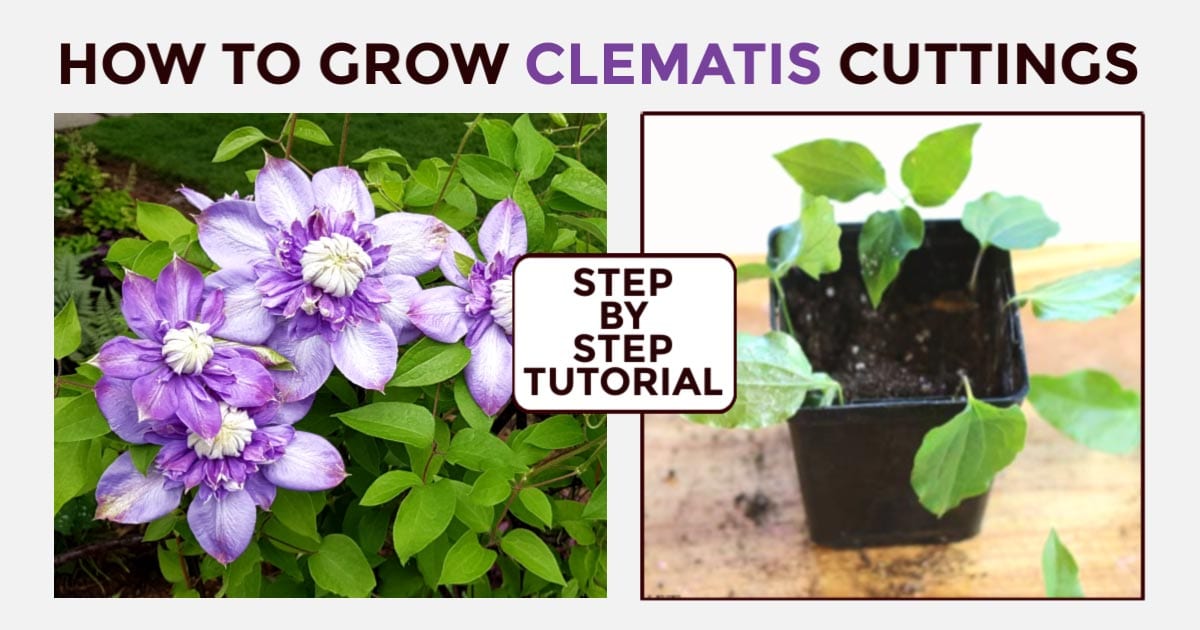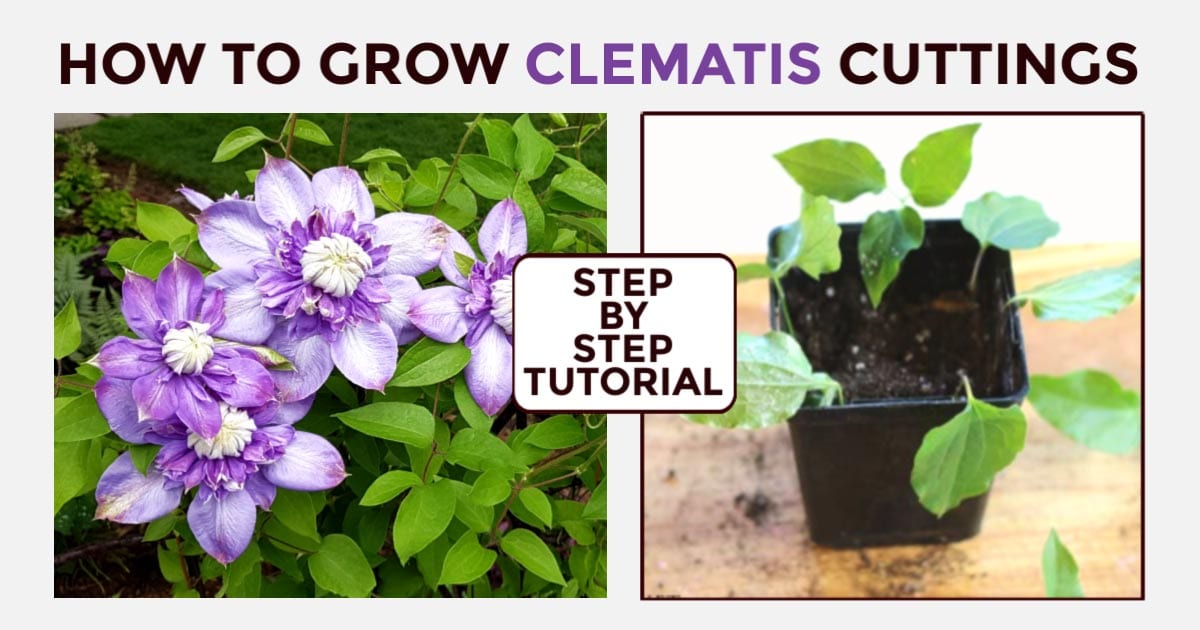How to Create a Stunning Clematis Garden Using Proven Propagation Techniques is a comprehensive guide that unlocks the secrets to cultivating vibrant clematis vines. This journey delves into the world of these captivating flowers, exploring their diverse types and unique characteristics.
You’ll learn to select the perfect clematis varieties for your garden, considering their growth habits, color palettes, and individual needs.
This guide unravels the art of propagation, guiding you through the intricacies of cuttings, layering, and division. You’ll master the timing, techniques, and tools necessary to successfully propagate clematis, ensuring a flourishing garden filled with these beautiful blooms.
Understanding Clematis: The Vine of Beauty

Clematis, with its vibrant blossoms and graceful vines, is a beloved choice for gardeners seeking to add a touch of elegance and color to their landscapes. Understanding the different types of clematis and their unique characteristics is crucial for selecting the right varieties for your garden and ensuring their success.
Clematis Types and Their Characteristics
Clematis varieties are categorized based on their flowering habits and pruning requirements. This classification helps gardeners choose the right clematis for their specific needs and garden design.
- Group A: Early-Flowering Clematis: These varieties bloom on the previous year’s growth, typically in spring. They require minimal pruning, as cutting back the stems can affect flowering. Examples include Clematis alpinaand Clematis macropetala.
- Group B: Late-Flowering Clematis: These clematis produce flowers on new growth, typically from late spring to summer. They benefit from hard pruning in late winter or early spring, which encourages vigorous growth and abundant blooms. Examples include Clematis jackmaniiand Clematis viticella.
- Group C: Reblooming Clematis: These varieties produce flowers on both old and new growth, allowing for extended periods of bloom. They require moderate pruning, typically in late winter or early spring, to encourage both new and old growth. Examples include Clematis ‘Nelly Moser’and Clematis ‘Ernest Markham’.
Selecting the Right Clematis Varieties
Choosing the right clematis varieties for your garden depends on factors such as the desired bloom time, flower color, size, and growth habit. Consider the following tips for selecting clematis that will thrive in your landscape:
- Bloom Time: Choose varieties that flower during the desired time of year, taking into account your local climate and growing season.
- Flower Color: Clematis come in a wide range of colors, from white and pastels to vibrant reds, purples, and blues. Select colors that complement your existing garden design or create a desired focal point.
- Flower Size: Clematis varieties have flowers ranging in size from small to large. Consider the scale of your garden and the desired visual impact when choosing flower size.
- Growth Habit: Clematis can be trained to grow vertically, horizontally, or even cascade over walls and fences. Select varieties that match your desired growth pattern and available space.
Ideal Growing Conditions for Clematis
Clematis thrive in well-drained soil and prefer a sunny location with some afternoon shade. They are also relatively drought-tolerant, but regular watering is essential, especially during dry periods.
- Light: Clematis prefer full sun to partial shade, with at least 4 hours of direct sunlight per day. In hot climates, afternoon shade is beneficial to prevent scorching of the leaves.
- Soil: Clematis require well-drained soil with a pH of 6.0 to 7.0. They prefer a soil mixture that is rich in organic matter.
- Climate: Clematis are hardy plants that can tolerate a wide range of climates. However, they are sensitive to extreme temperatures, particularly frost and heat.
Mastering Propagation Techniques
Propagation is the art of creating new clematis plants from existing ones. This process allows you to expand your garden with beloved varieties and share your passion with fellow gardeners. There are several methods of clematis propagation, each with its own advantages and disadvantages.
By understanding the techniques, you can choose the best method for your needs and achieve successful results.
Cuttings
Cuttings involve taking a section of stem from a healthy clematis plant and encouraging it to develop roots. This is a common and effective method for propagating many clematis varieties.
Softwood Cuttings
Softwood cuttings are taken from new growth that is still soft and pliable. This method is best suited for clematis varieties that are actively growing.
- Timing:The ideal time for taking softwood cuttings is in late spring or early summer when the new growth is fully developed but still flexible.
- Tools:You will need sharp pruning shears or a knife, a rooting hormone, and a pot or tray filled with a well-draining potting mix.
- Technique:
- Select a healthy stem with several nodes (the points where leaves grow).
- Cut the stem just below a node, making a clean, angled cut.
- Remove the leaves from the bottom 1-2 inches of the stem.
- Dip the cut end of the stem in rooting hormone.
- Insert the stem into the potting mix, leaving the top 2-3 nodes above the soil level.
- Water the cuttings thoroughly and place them in a bright, indirect light location.
- Maintain a consistently moist environment by misting the cuttings regularly and covering them with a clear plastic dome or bag to create a mini-greenhouse effect.
Semi-Hardwood Cuttings
Semi-hardwood cuttings are taken from stems that have begun to harden but are not yet fully woody. This method is suitable for a wider range of clematis varieties and can be done later in the season.
- Timing:Semi-hardwood cuttings are taken in late summer or early fall when the new growth has matured but is still somewhat pliable.
- Tools:The same tools as softwood cuttings are needed, including sharp pruning shears or a knife, rooting hormone, and a pot or tray filled with a well-draining potting mix.
- Technique:
- Select a healthy stem with several nodes (the points where leaves grow).
- Cut the stem just below a node, making a clean, angled cut.
- Remove the leaves from the bottom 1-2 inches of the stem.
- Dip the cut end of the stem in rooting hormone.
- Insert the stem into the potting mix, leaving the top 2-3 nodes above the soil level.
- Water the cuttings thoroughly and place them in a bright, indirect light location.
- Maintain a consistently moist environment by misting the cuttings regularly and covering them with a clear plastic dome or bag to create a mini-greenhouse effect.
Advantages of Cuttings
- Relatively easy:Cuttings are a relatively simple propagation method that can be successful with a little patience and care.
- Fast results:Cuttings can root within a few weeks to a few months, depending on the variety and the conditions.
- Multiple plants:One plant can produce many cuttings, allowing you to increase your clematis collection quickly.
Disadvantages of Cuttings
- Not all varieties:Some clematis varieties are difficult to propagate from cuttings, especially those that are grafted or have a strong tendency to revert to their rootstock.
- Requires attention:Cuttings need consistent care, including watering, misting, and monitoring for pests and diseases.
- Success rate:The success rate of cuttings can vary depending on the variety, timing, and technique.
Layering
Layering is a method of propagation that involves encouraging a stem to root while it is still attached to the parent plant. This technique is particularly effective for clematis varieties that are difficult to root from cuttings.
Air Layering
Air layering involves rooting a stem that is still attached to the parent plant, but above the soil level. This method is often used for clematis varieties that are difficult to root from cuttings.
Creating a stunning clematis garden often involves propagation techniques like cuttings or layering, but there’s another fascinating world of propagation to explore – carnivorous plants. If you’re looking for a unique challenge, Discover the Fascinating World of Venus Fly Trap Propagation Today! and learn how to cultivate these captivating creatures.
Returning to clematis, remember that consistent care and proper propagation methods will help your garden thrive with vibrant blooms year after year.
- Timing:Air layering is best done in late spring or early summer when the plant is actively growing.
- Tools:You will need a sharp knife or pruning shears, rooting hormone, sphagnum moss, plastic wrap, and string or wire.
- Technique:
- Select a healthy stem that is about 1/2 inch in diameter.
- Make a cut about 1 inch long into the stem, just below a node.
- Gently peel back the bark on either side of the cut to expose the cambium layer.
- Dip the cut end of the stem in rooting hormone.
- Wrap the cut area with damp sphagnum moss and secure it with plastic wrap.
- Tie the plastic wrap securely to the stem above and below the cut area.
- Keep the sphagnum moss moist by misting it regularly.
- After a few months, roots should develop within the sphagnum moss.
- Once the roots are well-established, cut the stem below the rooted area and plant the new plant in a pot or in the ground.
Advantages of Layering
- High success rate:Layering has a very high success rate, especially for clematis varieties that are difficult to root from cuttings.
- Less demanding:Layering requires less care than cuttings, as the stem remains attached to the parent plant and receives nutrients and water.
- Preserves the parent plant:Layering does not harm the parent plant, unlike cuttings, which require taking a section of stem from the plant.
Disadvantages of Layering
- Limited number of plants:Layering produces only a few new plants from each parent plant.
- Slower growth:Layered plants may take longer to establish than cuttings, as they are still connected to the parent plant.
Division
Division is a propagation method that involves separating a mature clematis plant into multiple smaller plants. This method is most effective for clematis varieties that have multiple stems arising from a single root system.
- Timing:Division is best done in early spring or late fall when the plant is dormant.
- Tools:You will need a sharp spade or shovel and a pair of pruning shears.
- Technique:
- Dig up the clematis plant carefully, making sure to preserve as much of the root system as possible.
- Use a sharp spade or shovel to divide the root ball into smaller sections, each with at least one stem and a healthy root system.
- Prune back the stems of each division to encourage new growth.
- Plant the divisions in separate pots or in the ground, making sure to keep the root ball at the same level as it was in the original plant.
- Water the divisions thoroughly and keep them moist until they are established.
Advantages of Division
- Quick and easy:Division is a relatively quick and easy propagation method that can be done with minimal tools and effort.
- Multiple plants:One plant can be divided into several new plants, allowing you to quickly expand your clematis collection.
- Healthy plants:Divided plants are generally healthy and vigorous, as they have established roots and stems.
Disadvantages of Division
- Limited to mature plants:Division can only be used for mature clematis plants that have multiple stems arising from a single root system.
- Can be disruptive:Division can be disruptive to the parent plant, especially if it is not done carefully.
Designing a Stunning Clematis Garden
Creating a captivating clematis garden involves strategic planning and a deep understanding of these versatile vines. This section explores the art of designing a visually striking clematis garden, considering factors like plant arrangement, color combinations, and integration with other elements.
Clematis Garden Design Strategies, How to Create a Stunning Clematis Garden Using Proven Propagation Techniques
To create a stunning clematis garden, consider these design strategies:
- Planting Arrangements:The placement of clematis varieties is crucial for maximizing visual appeal and ensuring optimal growth conditions. A well-designed garden utilizes a mix of different growth habits and color palettes to create a dynamic and visually engaging space.
Clematis Variety |
Growth Habit |
Color |
Placement |
|---|---|---|---|
‘Jackmanii’ |
Large-flowered, vigorous |
Purple |
Back of a border or against a wall |
‘Nelly Moser’ |
Large-flowered, vigorous |
Pink |
Center of a border or over an archway |
‘Ville de Lyon’ |
Large-flowered, vigorous |
Red |
Near a fence or trellis |
‘Clematis montana ‘Rubens” |
Small-flowered, vigorous |
Pink |
Climbing over a pergola or arbor |
- Color Combinations:The color palette of your clematis garden can significantly impact its overall aesthetic. Consider the interplay of warm and cool colors, contrasting hues, and complementary shades. A well-balanced color scheme enhances the beauty of your clematis garden and creates a visually pleasing environment.
Creating a stunning clematis garden starts with strong, healthy plants. Proven propagation techniques, like cuttings or layering, can ensure you have a thriving vine, but sometimes, you need a little help from a “mother” plant. If you’re struggling to get your clematis cuttings to root, consider learning how to propagate a “Mother of Thousands” plant, as explained in this excellent guide: How to Make Your Mother of Thousands Propagation Easy and Successful.
The techniques used to propagate this unique plant can be adapted to help your clematis cuttings develop strong root systems and thrive in your garden.
Clematis Variety |
Growth Habit |
Color |
Placement |
|---|---|---|---|
‘Blue Angel’ |
Large-flowered, vigorous |
Blue |
Against a white wall or fence |
‘Mrs. Cholmondeley’ |
Large-flowered, vigorous |
White |
Near a vibrant yellow or orange flowering plant |
‘Pink Fantasy’ |
Large-flowered, vigorous |
Pink |
Against a backdrop of deep green foliage |
‘Crimson Star’ |
Large-flowered, vigorous |
Red |
Near a soft pastel-colored flowering plant |
- Integration with Other Plants and Structures:Clematis thrives when combined with other plants and structures that provide support, shade, and visual interest. Integrating clematis with complementary plants, such as roses, perennials, and shrubs, creates a rich tapestry of textures and colors. Structures like arbors, trellises, and fences offer vertical support for clematis to climb and create stunning displays.
“A clematis garden is a canvas for creativity, allowing you to blend vibrant colors, diverse textures, and structural elements to create a truly breathtaking landscape.”
Nurturing Your Clematis

Providing the right care for your clematis is crucial for their health and vibrant blooms. This section will guide you through essential care practices, including watering, fertilizing, and pruning techniques.
Watering
Proper watering is essential for clematis, especially during their active growth period. Clematis thrive in consistently moist soil, but they also require good drainage to prevent root rot.
- Water deeply and infrequently, allowing the soil to dry slightly between waterings.
- During hot and dry weather, you may need to water more frequently.
- Mulching around the base of the plant helps retain moisture and suppress weeds.
Fertilizing
Clematis benefit from regular fertilization, particularly during their growing season. Fertilizers provide essential nutrients that promote healthy growth and abundant blooms.
- Use a balanced fertilizer formulated for flowering plants, following the instructions on the label.
- Apply fertilizer in the spring and early summer, avoiding excessive fertilization, which can harm the plants.
- Organic fertilizers, such as compost or manure, are also beneficial for clematis.
Pruning
Pruning is an essential aspect of clematis care, as it encourages healthy growth, promotes flowering, and helps control the plant’s size and shape. The specific pruning technique depends on the clematis group.
- Group 1:These clematis bloom on old wood (growth from the previous year) and should be pruned lightly after flowering.
- Group 2:These clematis bloom on both old and new wood and can be pruned in late winter or early spring.
- Group 3:These clematis bloom on new wood and should be pruned hard back in late winter or early spring.
“Always use sharp, clean pruning shears to avoid damaging the plant.”
Pests and Diseases
While generally hardy, clematis can be susceptible to certain pests and diseases. Early detection and appropriate treatment are crucial for preventing significant damage.
- Common Pests:Clematis are susceptible to aphids, spider mites, and Japanese beetles.
- Common Diseases:Clematis wilt, powdery mildew, and leaf spot are common diseases that can affect clematis.
- Prevention and Treatment:Regular inspection, proper watering, and good air circulation help prevent pests and diseases. If problems arise, consider using insecticidal soap or fungicides.
Inspiring Clematis Garden Ideas: How To Create A Stunning Clematis Garden Using Proven Propagation Techniques

A well-designed clematis garden can be a breathtaking sight, adding vertical interest, vibrant colors, and captivating textures to your outdoor space. Clematis vines are versatile and adaptable, thriving in various settings, from small courtyards to expansive gardens. By carefully selecting clematis varieties, supporting structures, and accompanying plants, you can create a garden that is both visually stunning and ecologically sound.
Examples of Stunning Clematis Gardens
Here are a few examples of stunning clematis gardens that showcase the diverse possibilities of these beautiful vines:
- A romantic cottage garden might feature a trellis covered in the fragrant, pale pink blooms of ‘Nelly Moser’ clematis, complemented by lavender and roses for a sweet and delicate ambiance. The trellis, crafted from weathered wood, adds a rustic charm, while the soft hues of the flowers create a sense of tranquility.
- A modern minimalist garden might incorporate a sleek, geometric metal obelisk adorned with the deep purple blooms of ‘Jackmanii’ clematis. The stark contrast of the dark flowers against the silver metal creates a striking visual impact. The garden could also feature other modern elements, such as gravel paths and architectural grasses.
- A vibrant, tropical-themed garden could showcase the large, showy blooms of ‘Ville de Lyon’ clematis, with its striking combination of red and white petals. The clematis could be trained to climb a bamboo archway, creating a dramatic focal point. The garden could be further enhanced with other tropical plants, such as banana trees and hibiscus.
Designing a Clematis Garden with Different Structures
Clematis can be incorporated into a variety of garden structures, adding vertical interest and creating a sense of depth and dimension.
Garden Theme |
Clematis Variety |
Supporting Structure |
Image Description |
|---|---|---|---|
Cottage Garden |
‘The President’ |
Rustic wooden arbor |
Imagine a weathered wooden arbor draped in the cascading, double-flowered blooms of ‘The President’ clematis. The soft pink petals, tinged with a hint of lavender, create a romantic and whimsical atmosphere. The arbor provides a shady spot for sitting and enjoying the garden’s beauty. |
Modern Garden |
‘Niobe’ |
Sleek metal trellis |
Picture a sleek, geometric metal trellis adorned with the large, star-shaped blooms of ‘Niobe’ clematis. The deep blue petals, accented by a white center, create a striking contrast against the silver metal. The trellis serves as a focal point in the garden, adding a modern touch to the landscape. |
Tropical Garden |
‘Ville de Lyon’ |
Bamboo archway |
Envision a towering bamboo archway covered in the vibrant blooms of ‘Ville de Lyon’ clematis. The large, showy flowers, with their striking combination of red and white petals, add a tropical flair to the garden. The archway creates a dramatic focal point, inviting visitors to explore the lush surroundings. |
Ultimate Conclusion
From understanding the fundamental needs of clematis to mastering propagation techniques, this guide equips you with the knowledge and inspiration to create a breathtaking clematis garden. As you learn to nurture your vines through proper watering, fertilizing, and pruning practices, you’ll discover the joy of watching these vibrant flowers thrive.
Let your creativity blossom as you integrate clematis into your garden design, using them to adorn trellises, arbors, and walls, creating stunning visual displays that will captivate all who behold them.
Clarifying Questions
What is the best time to prune clematis?
The best time to prune clematis depends on the type. Group 1 clematis are pruned in late winter or early spring, while Group 2 clematis are pruned after flowering. Group 3 clematis are pruned in late winter or early spring to encourage new growth.
What are some common clematis pests and diseases?
Common clematis pests include aphids, spider mites, and clematis wilt. Common diseases include powdery mildew, leaf spot, and root rot.
